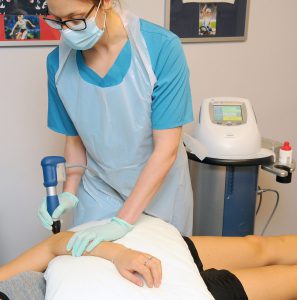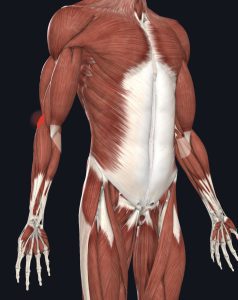Tennis Elbow
Tennis elbow is a painful condition that affects the outside (lateral) part of the elbow. This is primarily a tendon-related problem affecting the common extensor tendon which is the attachment point for 5 muscles of the hand, wrist and forearm. In tennis elbow, the tendon and/or its attachment to the bone (lateral epicondyle of the humerus) becomes irritated and may involve inflammation. It has several other names that reflect the nature of the problem, such as lateral epicondylitis, lateral epicondylopathy, common extensor tendinopathy and lateral elbow pain. Sometimes the nerves in this area can be involved, especially the posterior interosseous nerve.
The problem is normally brought about through an overuse mechanism, such as unaccustomed lifting, gripping or sporting activities. Once aggravated, seemingly simple tasks like lifting a mug, opening a door, lifting a shopping bag or shaking hands can aggravate symptoms. Sometimes simply avoiding the aggravating activities and gradually building activity back up is sufficient to resolve the issue. However, if people persist with aggravating activities the severity of the problem can increase and symptoms can become more intense and more continuous.
Diagnosis can be made by a musculoskeletal specialist such as a physiotherapist, sports doctor or orthopaedic surgeon. Most of the time, the diagnosis can be made through detailed clinical examination, however occasionally a scan, such as ultrasound, can be useful to ensure no tears or other tendon problems (i.e. calcification) are present.
While many therapies and professionals are involved with treating tennis elbow, the main treatments are:
- Physiotherapy based rehabilitation (may include manual therapy and taping)
- Shockwave Therapy
- Injection therapy
Physiotherapists will be able to assess and diagnose the problem (occasionally an ultrasound scan can be useful to assist with diagnosis) and then commence treatment. Treatment will be based around rehabilitation, as this has the strongest evidence to support it, however you may also be offered manual therapy, supportive taping and advice on how to modify your activities appropriately.


Our physiotherapy team are also skilled in the use of shockwave therapy, which is a non-invasive form of treatment that is shown to be effective in the treatment of tennis elbow. In this therapy, high energy sound waves are directed towards the affected region via a hand-piece attached to a shockwave system. Shockwave therapy, coupled with a well designed and progressive rehabilitation program, has scientific evidence to support its use and the majority of patients will make an excellent recovery following this approach.
For persistent or exceptionally debilitating tennis elbow, patients can consider injection therapy. There are many different types of injection therapy that can be offered for tennis elbow, however the most commonly administered is a steroid (cortisone) injection. This is however controversial as several studies have shown steroid injections to have a negative impact on tennis elbow in the longer term. That said, in some circumstances it remains a possible option. Hyaluronic acid is another type of injection that can be offered at Life Fit Wellness and there is some supporting evidence to suggest its effectiveness and safety for tennis elbow. Essentially this is a lubricating injection that helps the affected tendons glide more freely. All injections at Life Fit Wellness are performed under ultrasound guidance to ensure their accuracy.









